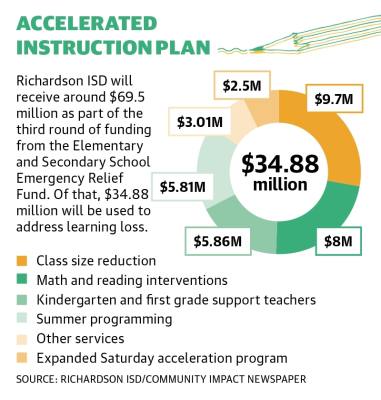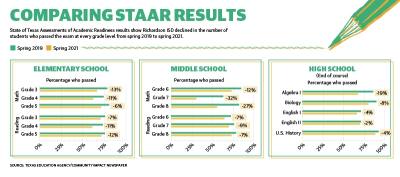While learning loss can take different forms for different students, RISD’s decreases in State of Texas Assessments of Academic Readiness scores were a tangible sign of the pandemic’s effect on education.
Results released in June show across-the-board declines in the number of RISD students who passed the STAAR exam compared to 2019.
STAAR was canceled in spring 2020 due to the pandemic.
Middle school math scores were among the most significant drops seen by the district. The percentage of RISD seventh-graders who passed the STAAR decreased 32 percentage points from 2019 to 2021, while eighth-grade math scores declined by 27 points.
During the Aug. 9 board of trustees meeting, RISD Superintendent Jeannie Stone said it is imperative that the district address learning loss accrued over the last 16 months.
"There’s a reason that the federal government has released billions of dollars to the state and millions of dollars [to districts] in the name of academic acceleration,” Stone said. “We owe it to our kids to be able to attack it and address it with a level of urgency.”
Academic acceleration
RISD is part of the state’s Region 10 Education Service Center, which offers professional development and other assistance to North Texas school districts. Region 10 Executive Director Gordon Taylor said plans to address learning loss have to be individualized for different students.
“Waving a ‘Harry Potter’ wand to make learning come back for every student the same way doesn’t exist,” Taylor said.
Texas plans to use most of the funding from the first two rounds of the Elementary and Secondary School Emergency Relief Fund to ensure school districts receive state funding based on projected enrollment despite attendance declines for the last two school years. The third round of ESSER funds are slated to be distributed to districts as grants. Districts are required to spend at least 20% of those funds on addressing learning loss.
RISD targeted students in need of help almost as soon as the last school year ended, RISD Deputy Superintendent Tabitha Branum said. The district’s summer programming served more than 9,000 students from every grade level this year, she added.
The district’s spending on its summer programming included increasing teacher compensation and making more opportunities available to students, Branum said. She also mentioned plans to address class sizes at elementary campuses and at the secondary level as significant investments being made via the district’s funding from the Elementary and Secondary School Emergency Relief Fund.
RISD’s academic acceleration plan includes one-time expenses of $4.1 million and a two-year recurring cost of $28.22 million. School districts have until Sept. 30, 2024, to spend the third round of ESSER funds, so RISD could have held back more of the money for the 2023-24 budget year. But Branum said the district felt an urgency to address learning loss as soon as possible. One area of focus for the district is making sure second graders are prepared for their first STAAR exam during the 2022-23 school year.
“Our goal is that 100% of them are reading on grade level by the time that they’re in third grade,” she said. “We’re going to commit these next two years to making that happen.”
School year challenges
Texas Education Commissioner Mike Morath said during a June 23 State Board of Education meeting that the statewide STAAR scores are “problematic” and the pandemic damaged the state school system.
During a June 28 press conference, Morath said districts with a higher percentage of students learning virtually saw greater declines in STAAR results. Branum said around 35% of RISD’s students remained in virtual learning throughout the 2020-21 school year.
“At some points, we had over 50% of our students that were still virtual even [into] the second nine weeks,” Branum said during the Aug. 9 meeting. “These [STAAR] scores were not a complete surprise. We knew, especially in mathematics, that learning loss was going to be more significant than in reading.”
Branum said the transition of teaching math from in-person to virtual was not as smooth as continuing the district’s momentum in phonics instruction and reading comprehension.
“Our educators did a phenomenal job in managing [their classroom] environment,” she said during the meeting. “They were asked every day to really teach and lead teaching, both for students who were sitting in face-to-face instruction, and then also students who might be ... in a virtual environment.”
RISD announced Aug. 9 that it would offer a virtual school option for the first nine weeks of the 2021-22 school year for students too young to be vaccinated against COVID-19. Students in kindergarten through sixth grade who opt into the program will work with RISD virtual teachers on district curriculum both synchronously and asynchronously through Oct. 15.
The district plans to use the second round of federal ESSER funding to pay for its temporary virtual option, Branum said.
Need for STAAR data
RISD was among only a handful of districts statewide that advocated for STAAR to be administered during the 2020-21 school year, according to Stone.
“We knew that we needed this data to be able to see where our students were at the end of this pandemic year,” she said during the Aug. 9 meeting.
Students were required to take the STAAR in-person, so RISD officials made a significant effort to encourage students in virtual learning to come to school to take the exam, Branum said during the meeting.
Jacob Cortez, RISD executive director of accountability and continuous improvement, said 93% of students in grades that were supposed to take the STAAR did so during the spring semester. That number is lower than the STAAR participation RISD has seen in previous years, Branum said.
“We really did want to capture this data and know, [for] each and every student, what did that learning and what did that growth look like for this school year,” she said.
Branum said RISD students outperformed state averages in all tests. RISD also experienced less learning loss than several of its peer districts in Dallas County, she said during the meeting.
“Relatively speaking, we did OK during a really difficult time,” Branum said to Community Impact Newspaper. “We need to commend our teachers and our parents for supporting learning at home [so] our learning loss was not as significant as it could have been.”








